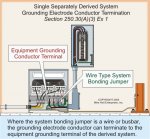Our company installs wind turbines that put put out 480 volts, some single phase some three. On the single phase units, I need to usually feed back to the home owner. To do this we use a single phase 480 - 120/240 transformer with a fused disconnect on either side.

I have been bonding the 240 volt disconnect with the supplied bonding screw and not bonding the case of the transformer or the 480 side. So I have 2 hots, a neutral and a ground from the 240 volt disconnect where it is bonded, terminate on the X side, then from the H side I have 2 hots and a ground going to the next disconnect. The grounds in the transformer terminate on a lug mounted to the case. This is acceptable isn't it? The turbine doesn't need a neutral.

I have been bonding the 240 volt disconnect with the supplied bonding screw and not bonding the case of the transformer or the 480 side. So I have 2 hots, a neutral and a ground from the 240 volt disconnect where it is bonded, terminate on the X side, then from the H side I have 2 hots and a ground going to the next disconnect. The grounds in the transformer terminate on a lug mounted to the case. This is acceptable isn't it? The turbine doesn't need a neutral.



